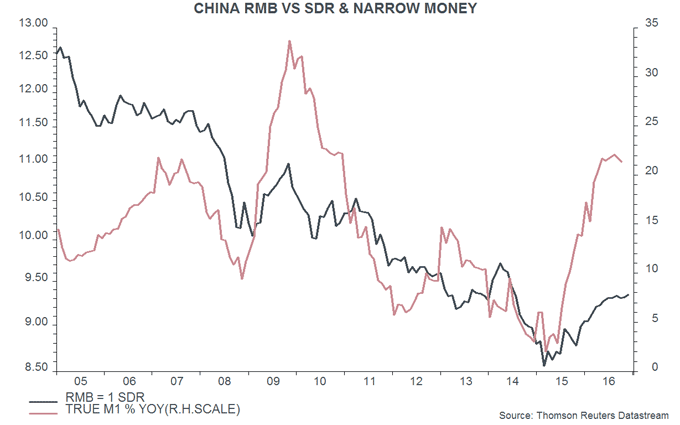Will the RMB recover in 2017?
China bears have been arguing for more than a year that capital outflows would tighten domestic monetary conditions, leading to economic weakness and deflation. The “monetarist” view has been that the bears have had the causation the wrong way round: loose policy since early 2015 has resulted in strong monetary growth, part of which has been exported, putting downward pressure on the currency. Capital outflows, in other words, have been a symptom of monetary laxity, not a cause of tightening.
The differing interpretations colour exchange rate forecasts for 2017. The bears argue that the capital exodus is related to overvaluation and financial system risks, and will continue. The monetarist view, by contrast, is that mounting inflationary pressures will force the authorities to tighten policy in early 2017, resulting in slower monetary growth and a corresponding reduction in outflows. With the current account remaining in healthy surplus (2.5% of GDP in the third quarter of 2016), this view suggests a resumption of upward pressure on the currency – unless the new US administration starts a trade war.
Domestic economic developments have largely followed the monetarist script during 2016. Policy loosening in early 2015 was reflected in a rise in monetary expansion between mid-2015 and mid-2016, with narrow money, in particular, surging. The monetary pick-up was followed by a strong acceleration of house prices from late 2015, a rebound in industrial profits from early 2016 and a return to producer price inflation more recently – see first chart.
Economic growth has also revived, although by less than was expected here, possibly due to a structural shift away from heavy industry, which may have reduced potential expansion. GDP growth, nevertheless, rebounded from an annualised 5.7% in the fourth quarter of 2015 / first quarter of 2016 to 7.6% in the second / third quarters, according to the National Bureau of Statistics (NBS). Business surveys, meanwhile, signal a much-improved climate: an average of NBS and Markit purchasing managers' indices covering manufacturing and non-manufacturing / services reached its highest level since 2013 in November.
Policy, however, is turning less expansionary in response to rising inflationary pressures. The authorities have introduced measures since October to take the froth off the housing market and could raise official interest rates in early 2017 as producer / consumer prices continue to accelerate – producer prices climbed 3.3% in the year to November, the largest annual gain since 2011. Recent firmer market rates may be early evidence of a policy shift, with the authorities choosing not to sterilise fully the impact of foreign exchange intervention and year-end demand for liquidity – in contrast to their approach earlier in 2016.
The weakening trend of the renminbi measured against the special drawing right (SDR) basket started as money growth picked up following policy loosening in early 2015 – second chart. Tighter policy and a monetary slowdown could be associated with upward pressure on the currency in 2017.

Reader Comments